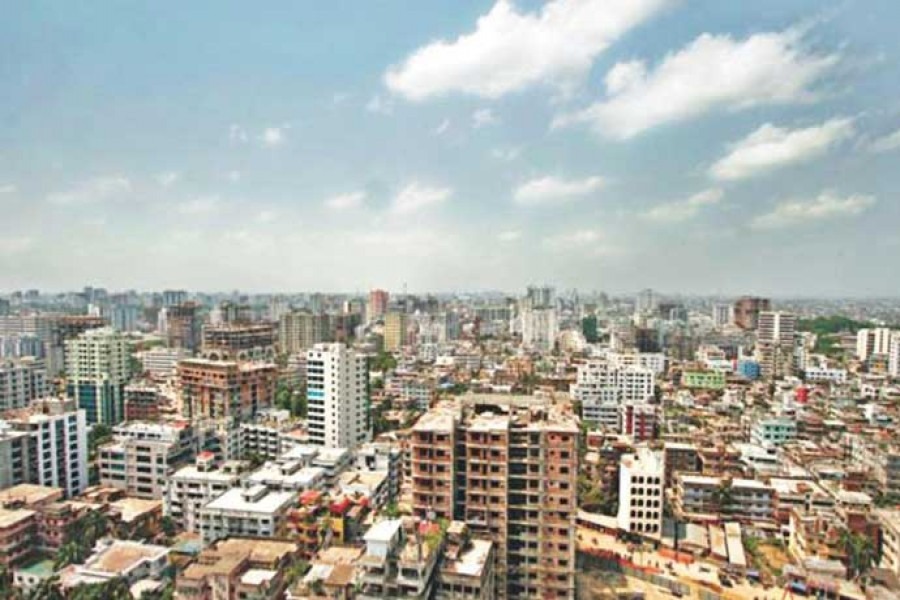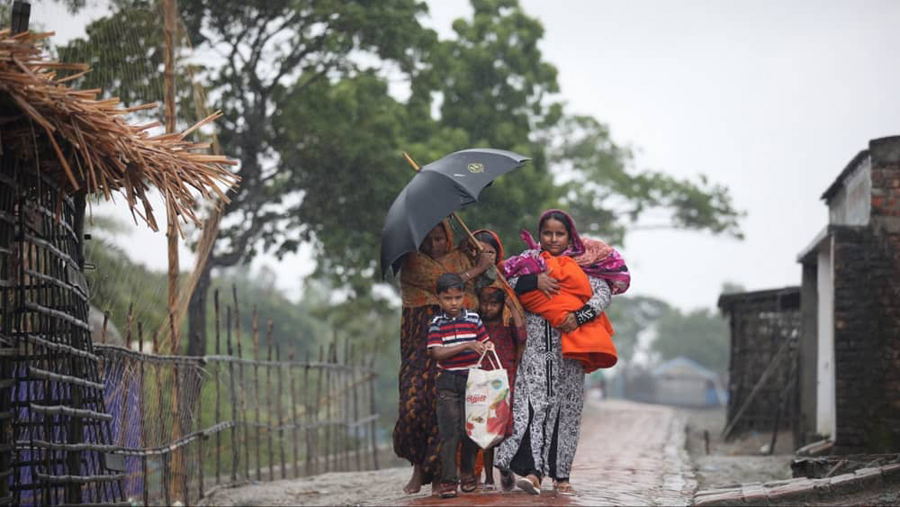Saif
Senior Member
- Joined
- Jan 24, 2024
- Messages
- 16,093
- Likes
- 8,059
- Nation

- Axis Group


Embankments in Sundarbans delta: Wall of hope or risk?
Embankments shape life, risk, and politics in the lower delta
Embankments in Sundarbans delta: Wall of hope or risk?

Infrastructure like embankments may be designed and built by engineers, but it is maintained by the community. FILE PHOTO: HABIBUR RAHMAN
"I have been living here for more than ten years. The embankment collapse caused by Amphan destroyed my whole house. Though we rebuilt it in the same location, we still feel fear when we hear cyclone warnings. This year is no exception."
At the end of May 2025, when the Bangladesh Meteorology Department announced a depression in the Bay of Bengal and its potential to develop into a cyclone, I had this conversation with Bariul Islam, whom I came to know through my ongoing dissertation fieldwork (2024-25) in the lower delta of the Bangladesh Sundarbans. Bariul's house is situated at the edge of the embankment that separates the village from the Sundarbans.
Living close to the embankment produces both hope and fear for people like Bariul. Here, I will highlight how embankments turn into ambivalent infrastructures and argue that infrastructure is not neutral; rather, it produces mixed and often contradictory impacts shaped by both nature and human actions.
In the lower delta, a traditional tidal river management system, known as austomashi badh, involved cutting dams during early monsoons to allow tidal waters to irrigate low-lying paddy fields. The delta's entire riverine network was disrupted during British rule by the construction of railways and river-based infrastructure such as bridges, culverts, and canals, as documented poignantly in Chas A Bentley's Malaria and Agriculture in Bengal and Sir William Willcocks' Lectures on the Ancient System of Irrigation in Bengal.
Modern embankments with polders and sluice gates were introduced in the 1960s through the Coastal Embankment Project (CEP), supported by Dutch consultants, USAID, and the World Bank, aiming to boost rice production by controlling floods during the Green Revolution. Many critics viewed the CEP as a "Eurocentric," technocratic solution that overlooked the delta's ecological complexity and its social and political dynamics.
After Cyclones Sidr (2007) and Aila (2009), the lower delta emerged as a new "climate frontier." The recent Coastal Embankment Improvement project aims to make existing embankments higher and wider to protect people and ecosystems from rising sea levels, salinity, and the increasing frequency of cyclones.
My ethnographic immersion with local people reveals competing experiences with the embankments. I found many landless families, displaced by riverbank erosion, had built homes on the southern (outer) side of the embankment. Embankments also serve as temporary refuges during cyclones, floods, and erosion.
On a large island near the Sundarbans, I observed a 31-kilometre concrete embankment under construction, already transforming local life. Battery-powered vans now provide quicker and more affordable transportation for goods and people. Islanders hope the embankment will shield them from cyclones and protect their homes, shrimp, and fish ghers. Almost everyone believes the new embankment will protect them from future cyclones. I found a clear sense of security when they spoke about it. To them, the embankment is more than soil and concrete; it is a social stage, a "wall of hope" where society performs its everyday life.
Despite its promised and expected benefits, embankments in the lower delta often fail to provide adequate protection for both humans and non-humans. Embankment collapses during cyclones like Sidr, Aila, Amphan, and Remal caused devastating floods, salinisation, and prolonged waterlogging.
Each time an embankment collapses, people immediately blame climate change. But this form of climate reductionism conceals the political ecology behind such collapses. Even if built with high-quality materials and sound engineering, one of the key causes of deterioration is damage by shrimp and fish gher owners. They cut into the base of embankments to bring saline water into their enclosures—an illegal practice often carried out by bribing government officials.
These gher owners are typically powerful local elites, closely connected to national politics, against whom government authorities rarely dare to act. It is, therefore, crucial to understand the politics behind embankment collapse rather than blindly blaming climate change.
I also visited several villages near the Sundarbans where many shrimp farmers now wish to return to paddy cultivation. In one village, farmers' collective efforts to resume rice farming turned into a signed petition to the UNO. But local elites blocked the process, making it difficult for small farmers to shift away from aquaculture, despite growing interest.
On May 25, people in the lower delta observed 16 years since Cyclone Aila. During my fieldwork, I encountered many damaged parts of embankments still awaiting government repair. "This embankment collapsed not because of the cyclone but because no one cared to repair it," one of my interlocutors told me bitterly. Another claimed that the government acquired his brother-in-law's land for embankment construction without offering any financial compensation. Eventually, embankments in the lower delta have become a deeply politicised infrastructure.
Despite living with constant risk, the encouraging aspect is the power of local people's remarkable adaptability. Embankment collapses frequently occur in the lower delta, yet men, women, and even children do not wait for government assistance.
When the water begins to recede during the ebb, announcements are made over mosque microphones, calling people to gather at the site with spades, baskets, and shovels. This collective spontaneity provides an important insight: infrastructure may be designed and built by engineers, but it is maintained by the community.
For them, the embankment is a lifesaver. Yet, they speak of it with uncertainty, aware that the same structure can collapse and drag them into danger. This coexistence of hope and risk, protection and insecurity, defines the delta's embankment. Unlike outsiders who view it as a technical fix, locals understand it as intertwined with memory, loss, labour, and solidarity.
Each part of an embankment's biography—its construction, use, collapse, and repair—tells us something profound about human society.
Fahmid Al Zaid is associate professor in Department of Anthropology, University of Dhaka, and a PhD candidate at Durham University, UK.
Infrastructure like embankments may be designed and built by engineers, but it is maintained by the community. FILE PHOTO: HABIBUR RAHMAN
"I have been living here for more than ten years. The embankment collapse caused by Amphan destroyed my whole house. Though we rebuilt it in the same location, we still feel fear when we hear cyclone warnings. This year is no exception."
At the end of May 2025, when the Bangladesh Meteorology Department announced a depression in the Bay of Bengal and its potential to develop into a cyclone, I had this conversation with Bariul Islam, whom I came to know through my ongoing dissertation fieldwork (2024-25) in the lower delta of the Bangladesh Sundarbans. Bariul's house is situated at the edge of the embankment that separates the village from the Sundarbans.
Living close to the embankment produces both hope and fear for people like Bariul. Here, I will highlight how embankments turn into ambivalent infrastructures and argue that infrastructure is not neutral; rather, it produces mixed and often contradictory impacts shaped by both nature and human actions.
In the lower delta, a traditional tidal river management system, known as austomashi badh, involved cutting dams during early monsoons to allow tidal waters to irrigate low-lying paddy fields. The delta's entire riverine network was disrupted during British rule by the construction of railways and river-based infrastructure such as bridges, culverts, and canals, as documented poignantly in Chas A Bentley's Malaria and Agriculture in Bengal and Sir William Willcocks' Lectures on the Ancient System of Irrigation in Bengal.
Modern embankments with polders and sluice gates were introduced in the 1960s through the Coastal Embankment Project (CEP), supported by Dutch consultants, USAID, and the World Bank, aiming to boost rice production by controlling floods during the Green Revolution. Many critics viewed the CEP as a "Eurocentric," technocratic solution that overlooked the delta's ecological complexity and its social and political dynamics.
After Cyclones Sidr (2007) and Aila (2009), the lower delta emerged as a new "climate frontier." The recent Coastal Embankment Improvement project aims to make existing embankments higher and wider to protect people and ecosystems from rising sea levels, salinity, and the increasing frequency of cyclones.
My ethnographic immersion with local people reveals competing experiences with the embankments. I found many landless families, displaced by riverbank erosion, had built homes on the southern (outer) side of the embankment. Embankments also serve as temporary refuges during cyclones, floods, and erosion.
On a large island near the Sundarbans, I observed a 31-kilometre concrete embankment under construction, already transforming local life. Battery-powered vans now provide quicker and more affordable transportation for goods and people. Islanders hope the embankment will shield them from cyclones and protect their homes, shrimp, and fish ghers. Almost everyone believes the new embankment will protect them from future cyclones. I found a clear sense of security when they spoke about it. To them, the embankment is more than soil and concrete; it is a social stage, a "wall of hope" where society performs its everyday life.
Despite its promised and expected benefits, embankments in the lower delta often fail to provide adequate protection for both humans and non-humans. Embankment collapses during cyclones like Sidr, Aila, Amphan, and Remal caused devastating floods, salinisation, and prolonged waterlogging.
Each time an embankment collapses, people immediately blame climate change. But this form of climate reductionism conceals the political ecology behind such collapses. Even if built with high-quality materials and sound engineering, one of the key causes of deterioration is damage by shrimp and fish gher owners. They cut into the base of embankments to bring saline water into their enclosures—an illegal practice often carried out by bribing government officials.
These gher owners are typically powerful local elites, closely connected to national politics, against whom government authorities rarely dare to act. It is, therefore, crucial to understand the politics behind embankment collapse rather than blindly blaming climate change.
I also visited several villages near the Sundarbans where many shrimp farmers now wish to return to paddy cultivation. In one village, farmers' collective efforts to resume rice farming turned into a signed petition to the UNO. But local elites blocked the process, making it difficult for small farmers to shift away from aquaculture, despite growing interest.
On May 25, people in the lower delta observed 16 years since Cyclone Aila. During my fieldwork, I encountered many damaged parts of embankments still awaiting government repair. "This embankment collapsed not because of the cyclone but because no one cared to repair it," one of my interlocutors told me bitterly. Another claimed that the government acquired his brother-in-law's land for embankment construction without offering any financial compensation. Eventually, embankments in the lower delta have become a deeply politicised infrastructure.
Despite living with constant risk, the encouraging aspect is the power of local people's remarkable adaptability. Embankment collapses frequently occur in the lower delta, yet men, women, and even children do not wait for government assistance.
When the water begins to recede during the ebb, announcements are made over mosque microphones, calling people to gather at the site with spades, baskets, and shovels. This collective spontaneity provides an important insight: infrastructure may be designed and built by engineers, but it is maintained by the community.
For them, the embankment is a lifesaver. Yet, they speak of it with uncertainty, aware that the same structure can collapse and drag them into danger. This coexistence of hope and risk, protection and insecurity, defines the delta's embankment. Unlike outsiders who view it as a technical fix, locals understand it as intertwined with memory, loss, labour, and solidarity.
Each part of an embankment's biography—its construction, use, collapse, and repair—tells us something profound about human society.
Fahmid Al Zaid is associate professor in Department of Anthropology, University of Dhaka, and a PhD candidate at Durham University, UK.










































